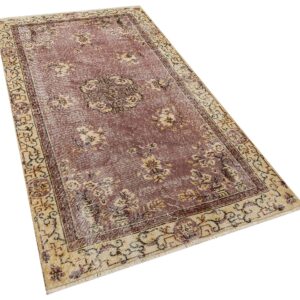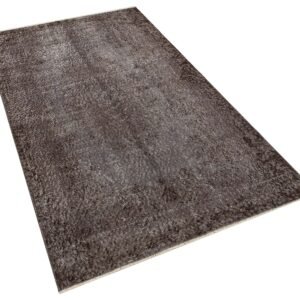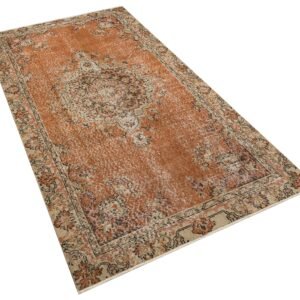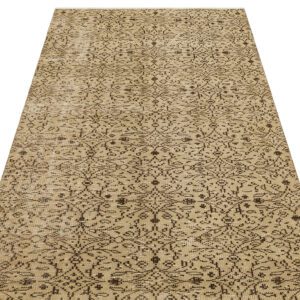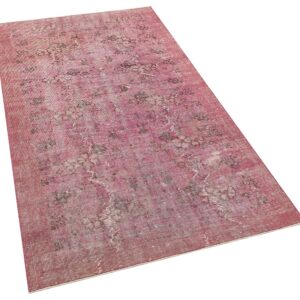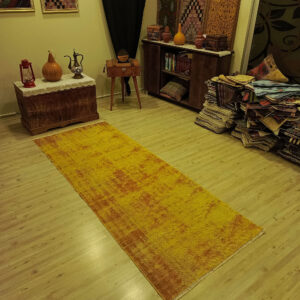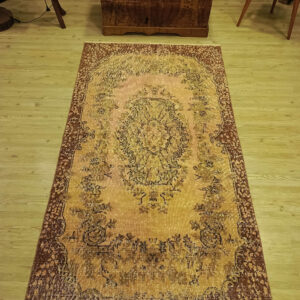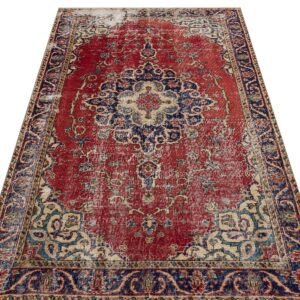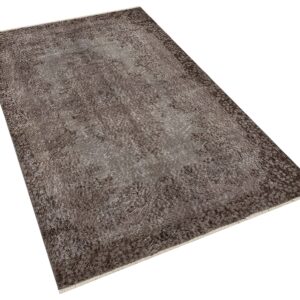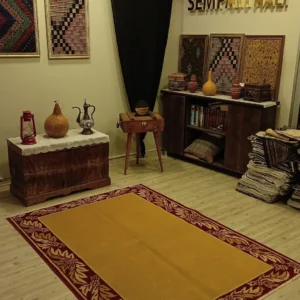- 2 Metrekare Halı
Geçmişten Gelen Dokunuşlarla Hazırlanmış Nostaljik Zemin Halı 119 x 210 cm 10021
₺7098 Sepete Ekle
Istanbul, the cultural hub of Turkey, is renowned for its rich history and stunning artisanship. One of the most treasured crafts from this city is the handmade Turkish rug. These rugs are not just decorative pieces, but also a symbol of the city’s rich heritage and culture.
The process of making a handmade Turkish rug is an intricate one that takes time and skill. The wool is first cleaned and then dyed using natural pigments. The dyes are made from plants, fruits, and other natural materials that are found in the region. Once the wool is dyed, it is then hand-knotted onto a loom using traditional techniques passed down through generations.
The patterns and designs on the rugs are influenced by the city’s diverse culture, with motifs such as geometric shapes, floral patterns, and traditional Turkish symbols. The rugs are often made in bold, vibrant colors, adding to their beauty and appeal.
When it comes to purchasing a handmade Turkish rug from Istanbul, it’s important to note that the price can vary greatly depending on the size, age, and condition of the rug. Antique rugs are considered the most valuable, as they are made using traditional techniques and materials that are no longer used today.
Despite the high price tag, many consider a handmade Turkish rug from Istanbul to be an investment piece, as it can last for decades, even centuries, with proper care and maintenance.
In conclusion, handmade Turkish rugs from Istanbul are a true work of art. Not only are they beautiful and unique, but they also tell the story of the city’s rich cultural heritage. If you’re looking for a piece that will add character and elegance to your home, a handmade Turkish rug from Istanbul is a great choice.
Awe-Inspiring Handmade Turkish Rugs from Istanbul
When one thinks of Istanbul, the first things that come to mind are its rich history and stunning architecture. But the city also boasts a long-standing tradition of crafting handmade Turkish rugs that are nothing short of awe-inspiring.
The process of making a handmade Turkish rug is a labor-intensive and time-consuming one. The wool is cleaned and dyed using natural pigments, and then hand-knotted onto a loom using traditional techniques. The result is a one-of-a-kind piece that is not only beautiful but also steeped in cultural significance.
The patterns and designs on the rugs are influenced by the city’s diverse culture, with motifs such as geometric shapes, floral patterns, and traditional Turkish symbols. The rugs are often made in bold, vibrant colors, adding to their beauty and appeal.
Handmade Turkish rugs from Istanbul are not just decorative pieces, but also an investment. Due to their high quality and durability, these rugs can last for decades, even centuries, with proper care and maintenance.
When it comes to purchasing a handmade Turkish rug from Istanbul, it’s important to note that the price can vary greatly depending on the size, age, and condition of the rug. Antique rugs are considered the most valuable, as they are made using traditional techniques and materials that are no longer used today.
In conclusion, if you’re looking for a piece that will add character and elegance to your home, a handmade Turkish rug from Istanbul is a great choice. Not only are they beautiful and unique, but they also tell the story of the city’s rich cultural heritage.
What is special about Turkish rugs?
Turkish rugs are known for their intricate designs, high-quality craftsmanship, and rich cultural heritage. Some of the special characteristics of Turkish rugs include:
- Intricate designs: Turkish rugs are renowned for their intricate and detailed designs, which often feature geometric patterns, floral motifs, and traditional Turkish symbols. These designs are influenced by the country’s diverse culture and history.
- High-quality craftsmanship: The process of making a Turkish rug is labor-intensive and time-consuming, requiring skill and expertise. The wool is cleaned and dyed using natural pigments, and then hand-knotted onto a loom using traditional techniques. This results in a high-quality, durable rug that can last for decades, even centuries, with proper care and maintenance.
- Rich cultural heritage: Turkish rugs are deeply rooted in the country’s cultural heritage, with each design and pattern telling a story. The rugs are often made in bold, vibrant colors, adding to their beauty and appeal.
- Variety of styles: Turkish rugs come in a variety of styles, from traditional and antique to modern and contemporary. Each style has its own unique characteristics, making it easy to find one that fits your personal taste and decor.
- Handmade: Many Turkish rugs are handmade, making each one unique. Handmade rugs are considered an investment piece as they are made with traditional techniques and materials that are no longer used today.
Overall, Turkish rugs are considered a true work of art, and are highly sought after for their beauty, quality, and cultural significance.
What are Turkish rugs called?
Turkish rugs are also known as Anatolian rugs, as Anatolia is the historical name for the region that is now Turkey. These rugs are traditionally woven by nomadic and village communities in various regions of Turkey, and are known for their intricate designs and high-quality craftsmanship. Some of the specific types of Turkish rugs are:
- Kilim: Kilim is a flat-woven rug that is made using a technique called tapestry weave. Kilim rugs have a unique, geometric design and are often made in bright colors.
- Ghiordes: Ghiordes rugs are made using the Ghiordes knot, which is a type of symmetrical knot. These rugs are known for their intricate designs and fine craftsmanship.
- Hereke: Hereke rugs are known for their fine craftsmanship and are considered some of the highest quality Turkish rugs. These rugs are made using the Ghiordes knot and are often made with silk or fine wool.
- Bursa: Bursa rugs are known for their bold, geometric designs and are made using the symmetrical knot.
- Konya: Konya rugs are known for their fine craftsmanship and are made using the symmetrical knot. The designs on these rugs are often influenced by Islamic art and architecture.
- Oushak: Oushak rugs are known for their soft colors, and are made using the symmetrical knot. They are made using high-quality wool and often feature geometric patterns and floral motifs.
These are just a few examples of Turkish rugs, there are many other types that are known for their unique characteristics and designs.
Are Turkish rugs the best?
Turkish rugs are considered some of the best in the world due to their intricate designs, high-quality craftsmanship, and rich cultural heritage. They are known for their durability and can last for decades, even centuries, with proper care and maintenance. Many Turkish rugs are handmade, making each one unique, and are considered an investment piece as they are made with traditional techniques and materials that are no longer used today.
However, it is also important to note that quality and value can vary greatly depending on the individual rug and the maker. There are many factors that affect the quality and price of a rug, such as the materials used, the craftsmanship, the age, and the condition. It’s important to do your research and understand the different types of Turkish rugs and their characteristics before making a purchase.
Additionally, there are many other countries that produce high-quality rugs, such as Persia, India, Nepal, and China. These countries also have their own unique styles and techniques, and many of them have a long history of rug-making. So, it’s a matter of personal preference and what you are looking for in a rug.
How can you tell if a Turkish rug is real?
There are several ways to determine if a Turkish rug is authentic:
- Look at the materials: Authentic Turkish rugs are made from high-quality wool, silk, and/or cotton. They are also made using natural dyes, which gives them a unique and vibrant color. If a rug is made with synthetic fibers or artificial dyes, it is likely not authentic.
- Check for a label or certificate of authenticity: Many authentic Turkish rugs will have a label or certificate of authenticity from the maker or seller. This can provide valuable information about the rug, including the materials used, the age, and the craftsmanship.
- Examine the knotting: Handmade Turkish rugs are usually made using a symmetrical or asymmetrical knotting technique. You can also check if the knots are tightly woven and even, which is a sign of good craftsmanship.
- Look for signs of wear and tear: Authentic Turkish rugs will show signs of wear and tear, such as frayed edges or slight fading. This is normal with handmade rugs and shows that they are not new.
- Compare it to other genuine rugs: Look at the design, quality, and craftsmanship of the rug you are considering, and compare it to other authentic Turkish rugs. Look for similarities and differences in the patterns, colors, and materials used.
It’s important to remember that it’s not always easy to tell if a rug is authentic, and even experts can be deceived. It’s a good idea to buy from reputable dealers or to have an expert appraise the rug before purchasing.
if you want to follow Turkish rugi and other handmade carpets, you can follow Sempatihali.com’s Instagram account. We share our new products and special discounts on our Instagram account. We also share information about how carpets are made and suggestions for use. To follow our Instagram account, leave us your name and e-mail address and we will let you know.

